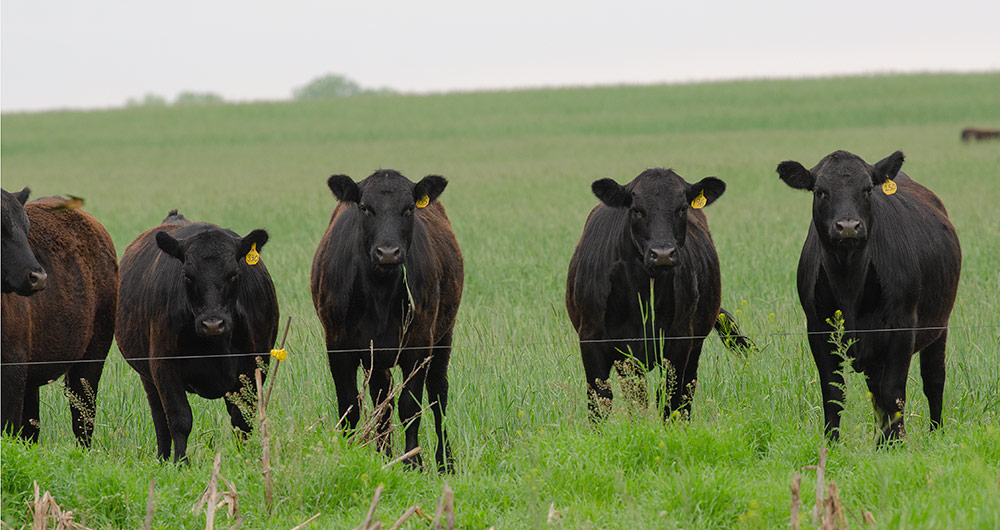
Avoid Weather-related Mineral Deficiencies
Research shows ways to avoid weather loss of minerals.
In 2019, severe spring weather included blizzards, floods and twisters that created serious management concerns for beef producers. Cattle reduced their mineral consumption because free-choice minerals likely washed away, lost effectiveness due to leaching, or were not provided consistently. Some producers concentrated only on moving animals to higher ground. Weather caused delays in working cattle, further disrupting supplementation and vaccination schedules.
Operators also faced the challenges of locating quality, carryover hay supplies. Some provided old hay bales that had lost nutrients to UV light and inclement weather. Harsh environmental conditions potentially stress cattle, causing them to deplete essential trace minerals. Severe weather events created a weather-induced mineral crisis.
Roberto Palomares, associate professor at the University of Georgia and director of Group for Reproduction in Animals, Vaccinology and Infectious Diseases (GRAVID), has studied the effects of injectable trace minerals (ITMs) on cattle immunity for five years. ITMs include copper, zinc, selenium and manganese. In a recent trial, Palomares immunized 48 one-month-old dairy calves with an intranasal modified-live virus (MLV) vaccine. Half of the animals received Multimin®90 ITMs, while the remaining half received saline solution.
Sixty days later, calves were assigned to four groups of 12 calves each:
- One set received intranasal MLV vaccine and another dose of ITM;
- One set received subcutaneous (sub-Q) MLV vaccine and ITM;
- One set received intranasal vaccine and saline solution; and
- One set, sub-Q vaccine and saline.
Twelve calves served as a control group, receiving neither vaccines nor ITMs.
“After 49 days, we challenged them with bovine viral diarrhea virus (BVDV) and infectious bovine rhinotracheitis virus (IBR),” Palomares reports. “Finally, we placed an endoscope into the upper respiratory tract to determine disease protection by determining the levels of inflammation and tissue damage.”
Since endoscopes are not routinely used in cattle, Palomares created a scoring system reflecting symptoms in sinus and nasal cavities; the nature of excretions; and the appearance of the larynx, trachea and bronchi. The control group, also challenged with BVDV and IBR, displayed significant inflammation, respiratory tract ulceration and soft-tissue nodules. BVDV commonly suppresses immunity, allowing highly infectious bacteria, such as Pasteurella multocida or Mycoplasma bovis, to cause secondary infections.
“The two groups receiving vaccines plus ITMs had significantly lower endoscopic respiratory clinical scores,” Palomares reveals. “Although those receiving vaccine only were protected from infection compared to unprotected animals. Animals receiving ITMs with vaccine had the highest positive statistical difference, suggesting that ITMs decreased inflammation and tissue damage caused by BVDV and IBR.”
Stress from inclement weather, weaning, shipping or vaccinations may result in excessive oxidant or free-radical production. These compounds damage cell DNA, nuclei and cell membranes. Both leukocytes (white blood cells) and neutrophils (specialized white blood cells) fight infection and are especially susceptible to oxidant damage.
Trace minerals, particularly copper, selenium and zinc, boost enzymes that neutralize free radicals. Zinc is also crucial for the growth of cells involved in DNA replication, such as white blood cells. Selenium also moves neutrophils to infection sites. Manganese converts cholesterol to estrogen and testosterone, which are necessary for reproduction. Trace minerals also have specific cell functions that optimize immune systems after vaccination. One injection of the ITM reduces deficiencies within one to eight hours, providing immediate benefits.
“Provide injections ... at critical times, such as weaning and vaccinations,” Palomares concludes. “Identify those procedures in your operation when stress will be higher. Using ITMs at those times is a good option.”
L.D. Barker, has a large-animal practice in Newcastle, Okla. He says trace minerals promote immunity levels, maintain animal health and production performance.
“We’ve seen an increase in disease during harsh weather; trace mineral deficiencies are occurring earlier in these animals,” Barker reports. “We encourage producers to vaccinate at three months instead of four months and to use ITMs each time. This protects animals from marginal and severe deficiencies, and producers readily get their animals on the same page. If animals are trace-mineral deficient, operators cannot maximize the return on their investment.”
Barker believes the failure of many vaccination programs is due to inadequate trace minerals. Animals cannot eat trace minerals fast enough to help the immune system respond effectively to the protective components in the vaccine.
Help during transitions
The Texas Panhandle, home to 5 million feedyard cattle, regularly receives shipments of stressed stockers. John Richeson, feedyard researcher at West Texas A&M University, says ITMs given to stocker and feedyard calves concurrently with MLV respiratory vaccines generate greater antibody responses to the antigens in the vaccine.
“Whether health and performance are improved depends on the trace-mineral status of individual animals and therefore the population,” Richeson explains. “Some research shows improved production outcomes when giving [an ITM] at initial stocker or feedlot processing or within 30 to 45 days of initial processing. ITMs stimulate cattle immune systems because trace minerals like zinc and copper are critical for several components of the immune response.”
Once in the feedlot, animals receive balanced diets with trace minerals included in the feed supplement, but that may not help trace-mineral-deficient calves catch up. Restoring trace minerals solely through the diet is difficult because newly received feedyard animals display low and erratic consumption. It takes longer to restore trace mineral levels solely through dietary means vs. adding ITMs. As a result, trace-mineral-deficient animals cannot reach their full potential for health and performance.
Richeson advises feedyard managers to prepare their staff members to receive weather-stressed cattle.
Producers can avoid a weather-induced mineral crisis in their herds when they manage stress, provide good feedstuffs and make sure a complete mineral is available at all times. By giving ITMs concurrently with vaccination and booster shots, producers can ensure improved immunity and performance.
Editor’s note: Gilda Bryant is a freelance writer from Amarillo, Texas. Photo by Kasey Brown.























